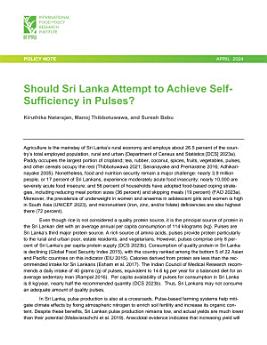Should Sri Lanka attempt to achieve self-sufficiency in pulses?
Natarajan, Kiruthika · Thibbotuwawa, Manoj · Babu, Suresh Chandra
Apr 2025 · Intl Food Policy Res Inst
Ebook
13
Pages
family_home
Eligible
info
reportRatings and reviews aren’t verified Learn More
About this ebook
Agriculture is the mainstay of Sri Lanka’s rural economy and employs about 26.5 percent of the country’s total employed population, rural and urban (Department of Census and Statistics [DCS] 2023a). Paddy occupies the largest portion of cropland; tea, rubber, coconut, spices, fruits, vegetables, pulses, and other cereals occupy the rest (Thibbotuwawa 2021; Senanayake and Premaratne 2016; Adhikari nayake 2005). Nonetheless, food and nutrition security remain a major challenge: nearly 3.9 million people, or 17 percent of Sri Lankans, experience moderately acute food insecurity; nearly 10,000 are severely acute food insecure; and 56 percent of households have adopted food-based coping strategies, including reducing meal portion sizes (36 percent) and skipping meals (19 percent) (FAO 2023a). Moreover, the prevalence of underweight in women and anaemia in adolescent girls and women is high in South Asia (UNICEF 2023), and micronutrient (iron, zinc, and/or folate) deficiencies are also highest there (72 percent).
Rate this ebook
Tell us what you think.
Reading information
Smartphones and tablets
Install the Google Play Books app for Android and iPad/iPhone. It syncs automatically with your account and allows you to read online or offline wherever you are.
Laptops and computers
You can listen to audiobooks purchased on Google Play using your computer's web browser.
eReaders and other devices
To read on e-ink devices like Kobo eReaders, you'll need to download a file and transfer it to your device. Follow the detailed Help Center instructions to transfer the files to supported eReaders.






